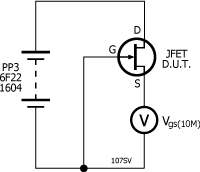I have 2 lots of 20 2n3819s i bought from Mouser (Central Semi) and eBay (Fairchild... possibly), the Central Semis all measure between 16 and 19mA IDSS when testing using a 9v battery and multimeter set to mA, and the eBay 'Fairchild' fets all measure between 13 and 16mA (marginally better but still nowhere near the numbers people have talked about in this thread....).
I tried the mic with one of the lowest IDSS values from the fets from mouser and it seemed to work, although the gain required to get much volume out of it was rather a lot, and the lowest value from the ebay fets also seems to work, however when i popped a few of the fets into my transistor tester both reported as actually being jfets but the values reported by it were wildly different between the two sets of transistors - i have attached a picture of the transistors and the values the tester shows - could someone give me some insight into why the values are so different? Im assuming it might be because the 'Fairchild' fets are perhaps not what they are labelled as!
As far as the gain is concerned to get a usable level out of the mic at a regular speaking volume - i tried with two interfaces, a focusrite 2i2 - this needed the gain turned up full and still comes out low, and a Audient ID44 which gets about the same level at 3/4 way round the gain knob, does this seem right?






![Soldering Iron Kit, 120W LED Digital Advanced Solder Iron Soldering Gun kit, 110V Welding Tools, Smart Temperature Control [356℉-932℉], Extra 5pcs Tips, Auto Sleep, Temp Calibration, Orange](https://m.media-amazon.com/images/I/51sFKu9SdeL._SL500_.jpg)





























